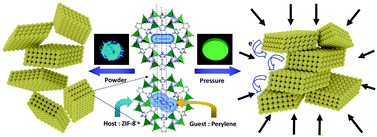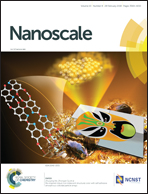Mechanochromic MOF nanoplates: spatial molecular isolation of light-emitting guests in a sodalite framework structure†
Abstract
Mechanochromic materials have a wide range of promising technological applications, such as photonics-based sensors and smart optoelectronics. The examples of mechanochromic metal–organic framework (MOF) materials, however, are still relatively uncommon in the literature. Herein, we present a previously undescribed Guest@MOF system, comprising “Perylene@ZIF-8” nanoplates, which will undergo a reversible 442 nm ⇌ 502 nm photoemission switching when subjected to a moderate level of mechanically-induced pressure at several tens of MPa. The nanoplates were constructed via high-concentration reaction (HCR) strategy at ambient conditions to yield a crystalline ZIF-8 framework hosting the luminous Perylene guests. The latter confined within the porous sodalite cages of ZIF-8. Remarkably, we show that in a solid-state condition, it is the spatial isolation and nano-partitioning of the luminescent guests that bestow the unique solution-like optical properties measured in the host–guest assembly. As such, we demonstrate that switchable red- or blue-shifts of the visible emission can be accomplished by mechanically modifying the nanoscale packing of the nanoplates (e.g. monoliths, pellets). Theoretical calculations suggest that the elasticity of the host's sodalite cage coupled with the intermolecular weak interactions of the confined guest are responsible for the unique mechanochromic luminescence behavior observed.



 Please wait while we load your content...
Please wait while we load your content...